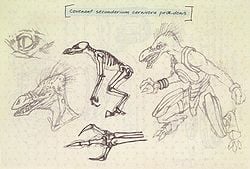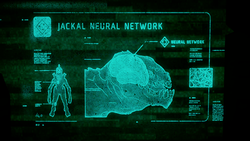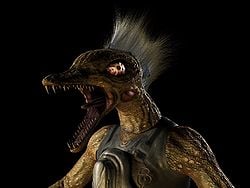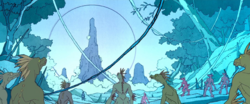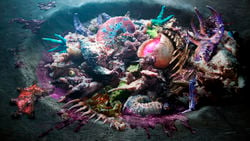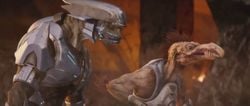Kig-Yar: Difference between revisions
From Halopedia, the Halo wiki
No edit summary |
No edit summary |
||
| Line 122: | Line 122: | ||
Kig-Yar names usually consist of a single syllable, with two consonants and one vowel, such as [[Yeg]], [[Jak]], and [[Bok]]. However, [[Chur'R-Yar]] and [[Chur'R-Mut]], who were both [[Shipmaster|shipmistresses]], have multiple syllables in their names. While some Kig-Yar possess clan names (e.g. [[Chol Von]], [[Eith Mor]]), most were not allowed by the Sangheili to have more than one name during their service in the Covenant—though most were not particularly bothered by the edict;<ref name="HE155"/> this limitation was abolished after the Covenant's dissolution. Some names are often more common among certain clans.<ref name="md142"/> | Kig-Yar names usually consist of a single syllable, with two consonants and one vowel, such as [[Yeg]], [[Jak]], and [[Bok]]. However, [[Chur'R-Yar]] and [[Chur'R-Mut]], who were both [[Shipmaster|shipmistresses]], have multiple syllables in their names. While some Kig-Yar possess clan names (e.g. [[Chol Von]], [[Eith Mor]]), most were not allowed by the Sangheili to have more than one name during their service in the Covenant—though most were not particularly bothered by the edict;<ref name="HE155"/> this limitation was abolished after the Covenant's dissolution. Some names are often more common among certain clans.<ref name="md142"/> | ||
The prefix "Chur'R-" is believed to indicate the | The prefix "Chur'R-" is believed to indicate the | ||
Revision as of 03:35, March 25, 2016
- "Jackals may be superior marksmen and they're very sneaky, but that doesn't make them excellent snipers — they’re a little too bloodthirsty for that."
- — Anonymous UNSC Marine
The Kig-Yar (sometimes rendered as "Kig-yar"; Forerunner designation: Perosus latrunculus, Latin for "hateful bandit";[1] human designation: Covenant secundarium carnivora prœdonis, Latin for "Covenant secondary carnivorous combatant"[2]), are a bird-like saurian species[3] which serve the Covenant as mercenaries and privateers.
There are several distinct races of Kig-Yar, though humans commonly identify the species according to two groupings (Jackals and Skirmishers) based on encounters in the battlefield. In combat, Kig-Yar typically serve as snipers and scouts within the Covenant due to their excellent senses of sight, smell, and hearing.[4]
History
The Ark and reseeding
The Kig-Yar were one of many species indexed by the Librarian as part of the Conservation Measure and preserved on Installation 00 from the firing of the Halo Array. They were subsequently returned to their homeworld, where they began rebuilding their culture.[5]
Development of civilization
During their early history, Kig-Yar society was divided into clans that sailed across Eayn's seas as pirates, raiding the encampments and settlements of rival clans.[6] Ancient Kig-Yar once experienced a gladiatorial era, similar to humans. These ancient Kig-Yar would hold inter-clan physical combat competitions in the largest population centers on Eayn's biggest continent.[7] Eventually, the clans united, and the Kig-Yar species worked together in developing space-travel technology.[8]
Shortly afterward, they established colonies on many small asteroids and planetoids around Chu'ot. The Kig-Yar on these asteroids were sustained by gray market trade and developed free from the government that dominated Eayn. Some Kig-Yar continued their ancient ways of life and became pirates once more, preying upon merchant starships. The piracy and looting in the system lead to the Kig-Yar government's militia recruiting selectively picked Commandos from sectarian societies from the asteroids that orbit Chu'ot. The Commandos fought off the pirates in an extremely ruthless and precise fashion.[7] When the overwhelming Covenant military juggernaut arrived in the Kig-Yar home system in 1342, the Kig-Yar pirates and militia joined forces in an attempt to fend off the alien intruders.[8]
The Covenant
At first, the Covenant arrived in the Kig-Yar home system with small contingent fleets. These fleets were directly attacked by ruthless Kig-Yar pirates and mercenaries, leading to a long naval war in the system.[9] Despite the sheer strength and numbers of the Covenant, the Kig-Yar used the Y'Deio system to their advantage. It was difficult for the larger Covenant ships to maneuver through Y'Deio's abnormally dense asteroid belt compared to the Kig-Yar's smaller vessels, while Kig-Yar forces could use the asteroids for hiding.[10] The war between the Covenant and Kig-Yar forces culminated in sieges of redoubts on the asteroids surrounding their world. Eventually, realizing the unlikelihood of them winning the war and the opportunity to profit from the expansion of trade, they accepted Letters of Marque: commissions from the Ministry of Tranquility to engage in the services of the Covenant, though often this was merely used as an excuse to continue their plundering lifestyle. The Kig-Yar would spend much of their time preying on the ships of the Covenant's enemies, such as humanity.[11]
Kig-Yar are around the same level as the Unggoy in the Covenant hierarchy, although the Kig-Yar despised the Unggoy and believed themselves to be superior. This reached a boiling point in 2462, when the growing Unggoy population on High Charity put pressure on the Kig-Yar as many of the Kig-Yar were forced to relocate their homes and nests to accommodate the Unggoy. The relocation caused stress for female Kig-Yar that were going through their incubation cycles, and Kig-Yar infant mortality rose on High Charity and the birth rate declined. To exact their revenge, a radical group of Kig-Yar shipmasters poisoned infusions—recreational narcotics the Unggoy enjoyed—on High Charity and on the vessels operated by the Kig-Yar which left many male Unggoy sterile.[12] Although a junior staffer in the Ministry of Concert found evidence of this, the High Council failed to properly investigate the incident, as they were willing to accept several thousand sterile Unggoy rather than risk upsetting the Kig-Yar. As a result, the offending Kig-Yar were not imprisoned and the guilty shipmasters were simply fined for damages. The lack of attention and the case's results eventually culminated to the Unggoy Rebellion.[13] The Unggoy began to attack, not only the Kig-Yar but, all other races in the Covenant. The Sangheili and Kig-Yar faced difficulty quelling the rebellion, which led to an Arbiter partially glassing Balaho to convince the Unggoy to surrender.[14]
Human-Covenant War
- Main article: Human-Covenant War
A Kig-Yar missionary ship, the Minor Transgression, was the first Covenant vessel to make contact with humanity.[15] The ship raided a commercial freighter leaving the planet Harvest, and the events that followed would later lead to full-scale military action on the part of humanity and the Covenant.[16] The Kig-Yar serving with the Ministry of Tranquility would continue to patrol the space around humanity's known territory. The Kig-Yar were responsible for discovering numerous human colonies, such as Madrigal, and would report their findings to the rest of the Covenant fleet.[17]
Following the outbreak of the Human-Covenant War, a group of Kig-Yar under Reth discovered the Rubble, a community of Insurrectionists and human survivors of the glassing of Madrigal, while attempting to mine the asteroids in the 23 Librae system.[18] Peter Bonifacio, a member of the Rubble Security Council, made contact with the Kig-Yar and agreed to trade Covenant weaponry in exchange for human slipspace drives.[19] Although the humans believed the Kig-Yar were rebels defying Covenant authority, they were in fact secretly proceeding with the blessing of the High Prophet of Truth to use the weapons to map UNSC space and learn the location of Earth and other human colonies.[20] Reth had created a Unggoy army on a nearby moon with the intents to attack the Rubble with it and use it for Kig-Yar nesting grounds. However, the plan fell apart due to the High Prophet of Regret sending Sangheili warriors to investigate the weapons, believing the Kig-Yar to be heretics.[21]
During the Great Schism, many Kig-Yar sided with the Jiralhanae troops loyal to the Hierarchs against the Sangheili. However, the Minister of Discovery predicted that the Kig-Yar would follow whichever side would lead them to profit.[22] Some Kig-Yar protested against the Jiralhanae and San'Shyuum at the dawn of the Schism.[23]
Post-war
Following the collapse of the Covenant and the end of the Human-Covenant War, the majority of Kig-Yar returned to a lifestyle of piracy and trade. The overall population and social makeup of the Kig-Yar remained stable following the end of the war, with their homeworld and major colonies experiencing manageable growth.[24] Many Kig-Yar had dealings with humans, as well as the former Covenant species, in independent locations such as Venezia; some took advantage of the Covenant's collapse and began to loot valuable materials and technology from former Covenant installations.[25]
A small number of Kig-Yar were enlisted as mercenaries by conservative Sangheili states,[24] while many served in the various Covenant remnant groups, including Merg Vol's Covenant and Jul 'Mdama's Covenant. A massive pirate faction had settled on the desolate world of Ven III by 2558.[26] A notable exception to the Kig-Yar's chiefly disparate mentality was Shipmistress Chol Von, who wished to gather a formidable naval force to defend the Kig-Yar home system from outside threats. However, few Kig-Yar shared her ambitions and her efforts ended up bearing little fruit.[25]
Description
Anatomy and physiology
Kig-Yar share many features with Earth avians as well as reptiles and exhibit several features that are common among species that have evolved in low-gravity environments.[27] Their legs are sinewy and muscular, and are reverse-jointed in a similar fashion to those of birds. Though they have been mistaken for carnivores,[2] the Kig-Yar are apparently an omnivorous species.[28][29] Kig-Yar have sharp beaks are lined with razor-sharp teeth, and their tri-digit hands and feet have sharp talons. Starved Kig-Yar have been known to eat the flesh of fallen enemies, as well as that of live prisoners. They are gifted with extraordinarily acute senses of sight, hearing, and smell, making them adept as scouts and snipers in the Covenant military. Kig-Yar are also very agile, and can execute swift jumps and rolls in combat; these abilities are most pronounced in the more muscular T'vaoan subspecies, members of which can leap great distances and cover ground at extremely high speeds. Kig-Yar possess a strong salty, occasionally acrid stench.[3][30]
Young Kig-Yar chicks are covered in a brown fledgling down which gradually molts and gives way to scales and plumage as they age.[31] Male Kig-Yar possess plumes of spiny quills (feathers in the case of Skirmishers) at the back of the head and on the elbows; the color of this plumage indicates the Kig-Yar's mood.[32] Quill color also varies between subspecies; Jackal quills typically have brown, red or light blue coloration, whereas Skirmishers generally have black or reddish feathers. Females lack these quills, instead having calloused plates at the forearms and the rear of the head. This thick skin helps protect the female during courtship: when mating, the male will often bite, chew, and tear at the back of the female's head, neck, and arms. Apart from these differences as well as those in reproductive organs, there is no meaningful physical variance between male and female Kig-Yar.[27]
While Kig-Yar have hollow avian bones[citation needed] and are physically frail, they are capable of moving quickly to evade harm. Their blood is bright purple in color, similar to that of the Sangheili, possibly showing a similar chemical makeup. They lack high amounts of calcium in their skeletons, which makes them a poor source of biomass for the Flood. Thus, Kig-Yar that are infected by the Flood are typically turned directly into carrier forms rather than combat forms. However, they have been utilized as combat forms during at least one engagement, the Battle of Shield World 0459.[33]
Subtypes
Unique even among the diverse assortment of the other client species of the Covenant, the Kig-Yar species has vast genetic variation within their race.[9] The Kig-Yar species is represented by at least three morphologically distinct subtypes. These include the mainstream "Jackals" of Ruuht,[34] the notably reptilian Jackals of Ibie'sh, and the more physically robust and more avian "Skirmishers" of T'vao. Many xenobiologists believe the morphological variation among the Kig-Yar likely represents diverging evolutionary pressures in response to varied environments and ecosystems on prehistoric Eayn and, subsequently, their various interplanetary colony worlds. However, all of the known variations of the species have the ability to effectively breed with all other subtypes of the Kig-Yar species and exhibit no marked cognitive differences.[9][35][36]
Jackals from Ruuht (known as Ruuhtians) typically exhibit light brown, tan, or sallow skin tones, with green skin appearing less often;[37][38] flexible quills on the head and forearms among males, with calloused plates among females; and elongated heads with bulbous eyes and beak-like snouts. The most common head morphology involves a downward-sloping snout,[39] though specimens with straight snouts are also common.[40][41][note 1]
Kig-Yar hailing from the isolated, volcanic continent of Ibie'sh (Ibie'shans) display the most "primitive" characteristics of all the known Kig-Yar subtypes, being closest to the species' common ancestor.[9] Ibie'shans have the same body structure as most of their kin, but their heads are far more muscular and reptilian in appearance, with shorter snouts and underbites.[38][42][43] These Jackals also differ from the more commonly seen variety in having reddish plumes and yellow-tinted eyes. Ibie'shans have served in the Covenant military as early as 2526[44] and now constitute the majority of Kig-Yar in Jul 'Mdama's Covenant.[9]
T'vaoans, commonly known as Skirmishers, originated from the Kig-Yar colony asteroid of T'vao.[45][46] They have darker skin and stockier, squared heads with small yellow eyes. They also have more beak-like mouths and bony facial coverings. T'vaoans have true feathers on their heads and arms, unlike the Jackals' quills. Like Jackals, T'vaoans have sharp talons on their hands and feet. While both subspecies are quite agile, T'vaoans are capable of sprinting at great speeds and leaping long distances. Male Kig-Yar from T'vao had much heavier upper body plumage than other Kig-Yar. Females from T'vao had a ruff of feathers on their heads and necks instead of scales.[47] The higher gravity and more dramatic atmospheric shifts of T'vao led to the development and evolution of these avian features.[9]
Culture
Kig-Yar are often considered to be driven and motivated solely by personal desires and needs.[9] Ancient Kig-Yar were once divided into clans, scattered across Eayn. The clans would often compete for resources and raid each other's cities or hold inter-clan competitions in major population centers.[7] During the Kig-Yar's service in the Covenant, the clans became slightly obsolete. However, many Kig-Yar still kept their roots to these clans, often living in territory that had been claimed by their clans ages ago. Parts of Myur City, on T'vao, had been once claimed by Chol Von's clan.[48] Kig-Yar clans often work together, unless one clan has grievances with another. Allied clans defend one another, if necessary.[49] The center of a clan is known as the "clan home" and often contains a "clan mother" to cook for the young.[50] Known clans include the Mor clan and the Gei clan.[51]
Piracy plays an important role in Kig-Yar society and history. While legitimate organizations, governments, and businesses are found throughout Kig-Yar society, pirates once plagued Eayn's seas. After becoming an interplanetary race, many Kig-Yar returned to piratical ways.[6] Many Kig-Yar chicks desire to be pirates when they grow up. Many Kig-Yar folklore heroes were pirates and represented freedom during the Kig-Yar's service with the Covenant. There were numerous Kig-Yar pirates that operated independently of the Covenant. These pirates would contact and ally themselves with like-minded Kig-Yar that served in the Covenant military. The Covenant-serving Kig-Yar would often contact the pirates when opportunities to steal Covenant supplies and materials arose.[4] Members of other species—including San'Shyuum, Sangheili, and humans—are often distrustful of the Kig-Yar, believing every member of the race to be a pirate.[52][53][54]
Social relations
Kig-Yar society is matriarchal, with males described as being “henpecked” by their females and having to toil for a living.[55] Early Kig-Yar society was a form of tyrannical matriarchy. Eayn's government would eventually spread power more widely and equally among the species, though females generally remained at the top. Before the Kig-Yar's indoctrination into the Covenant, female Kig-Yar were in control of breeding rights, territory, familial organization, and had control of major assets. The matriarchal-based society continued after the collapse of the Covenant empire.[9] The expectations of young male chicks are lower than their female counterparts. Kig-Yar females typically hop from mate to mate, however, males generally stay around their mate's nests for as long as they are tolerated.[56] T'vaoans believe themselves to be superior over the rest of the Kig-Yar.[57]
Kig-Yar have been known to coexist relatively peacefully with humans, as evidenced by the relationship between the Rubble and Reth's forces on Metisette, the cooperation of Kig-Yar miners on New Llanelli with Office of Naval Intelligence operatives,[58] and their relationship with Insurrectionists on Venezia.[59] When the Kig-Yar were finally ordered by the San'Shyuum to attack and destroy the humans of the Rubble, many of them even regretted the order. This is likely due to the pragmatic, mercantile culture of their race: As long as it benefits them economically, Kig-Yar will co-operate with nearly any group, even declared enemies of the Covenant.
Within Covenant society, Kig-Yar have little status and are subservient to all but the Unggoy. Because of this, Kig-Yar frequently harass Unggoy to assert what little authority they have. Despite being rather lowly-ranked in the Covenant, Kig-Yar are not typically disrespected by other races like the Unggoy. Thus, they had no true desire to gain a higher rank in the Covenant. Although, some Kig-Yar unsuccessfully protested their lowly position.[4] In some cases, Sangheili or Jiralhanae disposed of criminals or prisoners by feeding them to Kig-Yar convicts, who eat the victim alive.[60]
If any of their kin are killed, Kig-Yar may put out a bounty known as a mev-ut and go after the culprits. Due to their vicious nature, they particularly go after the heads and cervical vertebrae of their targets.[61]
Role within the Covenant
- "Yet some are effective snipers, and, once drawn into the Covenant they have proven loyal, though they are quarrelsome with the Unggoy and others at times."
- — From the Prophet of Clarity's Notes on the History of the Covenant, referring to the Kig-Yar[62]
The Kig-Yar are unique among Covenant races: rather than being faithful followers of the San'Shyuum's religion, they served the Covenant due to the monetary rewards the Prophets paid them. However, due to their long service in the Covenant, a large number of them came to accept the Covenant religion. Although the Kig-Yar held a rather low standing in the Covenant hierarchy, their position closely resembled a separate and independent entity that operated as mercenaries for the Covenant;[27] most Kig-Yar saw their service in the Covenant as a business arrangement, rather than a true religious and spiritual journey.[9] The Kig-Yar were not represented on the High Council but were instead vetted by the Ministry of Concert. The Kig-Yar did not vocally complain about their position but had instead selected to siphon off resources to their brethren, to which the Covenant powers either turned a blind eye to or were unaware of it.[4][63] Black markets were also operated on High Charity by the Kig-Yar; the Hierarchs were aware of it, but seemingly only monitored the markets.[64] Unlike some species in the Covenant,[27] the culture of the Kig-Yar did not suffer as a result of their incorporation to the hegemony. When the Covenant was dissolved at the end of the Human-Covenant War, Kig-Yar society and culture experienced little change.[9]
Kig-Yar served primarily as light infantry, police forces, overseers, and marksmen. They were commonly used for interdiction, infiltration, and assassination operations. Kig-Yar privateers also commonly crew Covenant missionary ships, such as the Minor Transgression. Originally, they were intended to replace the Unggoy as the foot soldiers of the Covenant, but their temperament made this impractical. Instead, they were assigned roles that were better suited to their natural abilities, such as scouts and snipers.[4]
Due to their unique position in the Covenant, the Kig-Yar often utilized starships of their own making instead of Covenant-made ones. In addition, they were forbidden to build their own slipspace drives, and had to rely on heavily regulated, unmodifiable drives engineered by the San'Shyuum instead.[65]
Government
The Kig-Yar government on Eayn is a post-industrial capitalist system, with a population of 978 million.[27] It is also described as an ochlocracy, a system of government best described as a government by mob, or the intimidation of constitutional authorities; whatever form of local government the Kig-Yar possess is ineffective and ignored. Before the Kig-Yar's inauguration to the Covenant, all colonies were self-governed. Due to the lack of Eayn's government, Kig-Yar colonists developed their economy based on the gray market. Eayn's government also had a functioning militia.[7] Clans often governed certain portions of cities on Kig-Yar worlds.[66]
After the Kig-Yar joined the Covenant, all of their governmental systems became obsolete. Following the Covenant's dissolution after the Human-Covenant War, the Kig-Yar had no true functioning government to control Eayn and its colonies. Instead, all Kig-Yar worked together, relatively cooperatively.[54] In April 2553, Chol Von attempted to form a united Kig-Yar navy and have all Kig-Yar clans unite, but few agreed that it was necessary.[67] By 2558, pseudo-governments have administrative control of Eayn's two supercontinents, Ruuht and Ah'lomet. There is controversy among both continents about which one has control of the small islands between the two.[68]
Language
- Main article: Kig-Yar language
To humans and other species, the Kig-Yar language is seemingly composed of hisses, growls, screeches, snarls, and squawks, though it is still intelligible to other members of the Covenant.[69] The Kig-Yar are able to speak the Sangheili language, which serves as the lingua franca to the Covenant. In addition, Kig-Yar are also capable of speaking the human English language in a rasped manner.[70] However, most Kig-Yar are unable to form a proper "f" sound in speech.[71] After the war, some Kig-Yar often spoke amongst each other speaking an odd mix of English, Sangheili, and the Kig-Yar dialect.[72]
Naming conventions
Kig-Yar names usually consist of a single syllable, with two consonants and one vowel, such as Yeg, Jak, and Bok. However, Chur'R-Yar and Chur'R-Mut, who were both shipmistresses, have multiple syllables in their names. While some Kig-Yar possess clan names (e.g. Chol Von, Eith Mor), most were not allowed by the Sangheili to have more than one name during their service in the Covenant—though most were not particularly bothered by the edict;[4] this limitation was abolished after the Covenant's dissolution. Some names are often more common among certain clans.[51]
The prefix "Chur'R-" is believed to indicate the
- ^ halo.bungie.org: Bestiarum Latin names translated
- ^ a b Halo: Reach, Dr. Halsey's personal journal
- ^ a b Bungie.net: ODST Guide
- ^ a b c d e f Halo Encyclopedia, pages 154-155 (2011 edition)
- ^ Halo Legends, Origins
- ^ a b Halo: Contact Harvest, page 93
- ^ a b c d Halo Encyclopedia, page 157
- ^ a b Halo Encyclopedia, page 115
- ^ a b c d e f g h i j Halo Waypoint: Kig-Yar
- ^ Halo: The Cole Protocol, page 157
- ^ Halo Encyclopedia, page 121 (2011 edition)
- ^ Halo: Contact Harvest, page 150
- ^ Halo: Contact Harvest, page 152
- ^ Halo 2: Anniversary, Terminal 10
- ^ Halo: Contact Harvest, page 26
- ^ Halo: Contact Harvest, page 134
- ^ Halo: The Cole Protocol, page 155
- ^ Halo: The Cole Protocol, pages 73-74
- ^ Halo: The Cole Protocol, page 222
- ^ Halo: The Cole Protocol, page 236
- ^ Halo: The Cole Protocol, page 146
- ^ Halo: Evolutions, "Wages of Sin", page 509
- ^ Halo 2, campaign level Gravemind
- ^ a b Eleventh Hour reports, Report 2
- ^ a b Halo: Mortal Dictata
- ^ Halo: Escalation, Issue #11
- ^ a b c d e Bestiarum
- ^ Halo: Mortal Dictata, page 73
- ^ Halo: Contact Harvest, page 49
- ^ Halo: Glasslands, page 159
- ^ Halo: Mortal Dictata, page 71
- ^ Halo: Contact Harvest, pages 56, 58
- ^ Halo Wars
- ^ Halo Waypoint: Catalog Interaction - Page 39
- ^ Halo Encyclopedia (2011), pages 56-57
- ^ Halo Waypoint: The Jackals
- ^ Halo Legends, Origins and Homecoming
- ^ a b Halo Waypoint: The Halo Bulletin: 9.24.14
- ^ Halo 3, Halo: Reach, and related media
- ^ Halo 2
- ^ Halo: Uprising
- ^ Halo 4
- ^ Halo 4: The Essential Visual Guide, page ???
- ^ Halo 4: Forward Unto Dawn
- ^ Halopedia:Letter - Re:Mortal Dictata Question
- ^ Halo: Mortal Dictata, Chapter 2
- ^ Halo: Mortal Dictata, Chapter 3
- ^ Halo: Mortal Dictata, page 68
- ^ Halo: Mortal Dictata, page 138
- ^ Halo: Mortal Dictata, pages 163-165
- ^ a b Halo: Mortal Dictata, page 142
- ^ Halo: Evolutions, "The Return", page 509
- ^ Halo: Broken Circle, page 266
- ^ a b Halo: Mortal Dictata, page 94
- ^ Halo: Mortal Dictata, page 60
- ^ Halo: Mortal Dictata, page 243
- ^ Halo: Mortal Dictata, page 272
- ^ Halo: Glasslands, page 113
- ^ Halo: Mortal Dictata, page 319
- ^ Halo 2, campaign level The Arbiter
- ^ Halo: Glasslands, page 218
- ^ Halo: Broken Circle, page 186
- ^ Halo: Contact Harvest, page 150
- ^ Halo: The Cole Protocol, page 146
- ^ Halo: The Cole Protocol, page 222
- ^ Halo: Mortal Dictata, page 167
- ^ Halo: Mortal Dictata, pages 74-75
- ^ Halo Waypoint: Catalog Interaction - Page 48
- ^ Halo: Combat Evolved
- ^ Halo: Glasslands, page 156-157
- ^ Halo: Mortal Dictata, page 394
- ^ Halo: Mortal Dictata, page 92
Cite error: <ref> tags exist for a group named "note", but no corresponding <references group="note"/> tag was found

